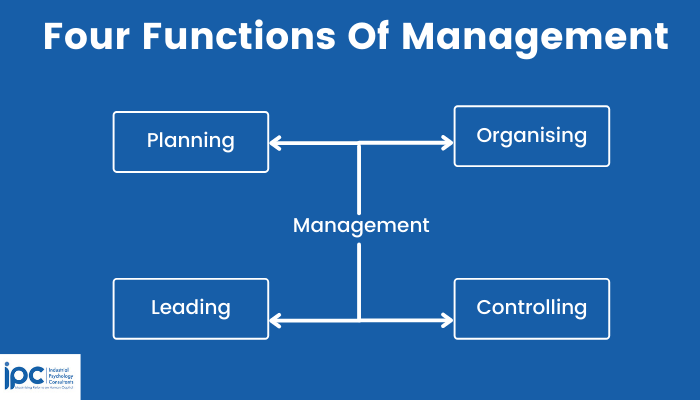When a person moves into a managerial role, they are constantly faced with some challenges when adapting to new responsibilities. Working under a manager might make one think that they know how to be a manager, but there are many things to learn. There are four essential functions that everyone needs to know when they get into management.
These are:
- Planning
- Organizing
- Leading
- Controlling
Before going into the functions of management, we need to know what management is about.
What is management?
Wikipedia defines management as the administration of an organization. It involves setting strategies and coordinating efforts for the organization’s success. When a person gets into a management position, they face several surprises. They realize that it is hard to lead and do not always know what is happening with their subordinates. Sometimes, what they do or do not do sends messages and signals. Without understanding the basic functions of management, it isn't easy to adapt to a management role.
Other definitions of management
Advertisment
- Management entails all actions and tasks undertaken for achieving organizational goals through planning, organizing, leading, and controlling.
- Management is the process of planning, leading, organizing, and controlling resources to reach goals effectively
- It is the set of activities directed at the efficient and effective utilization of resources to achieve goals.
- Working with human, financial, and physical resources to achieve organizational objectives by performing the functions of planning, organizing, controlling, and leading.
All the definitions of management highlight the importance of the four functions of management in using the organization’s resources to achieve goals and objectives.
Levels of Management
Management can be classified into the top-level, middle-level, and lower level, and their roles within the four functions are different.
- Top-level - This refers to the top leadership eg CEOs and directors, their job include coming up with strategic goals and plans. They set the strategic tone for the entire organization. Leadership skills are very essential at this level.
- Middle Level - Also known at the tactical level. The main focus is the implementation of plans and interpreting them to the lower levels. They also come up with tactical plans.
- Lower Level - This is the supervisory or operational level. Their role is to ensure full implementation of the plans.

Planning function of management
Managers have to plan to meet company goals. The first step in planning is to establish the company’s goals and then they decide on how to achieve them. They delegate responsibilities to subordinates and set appropriate timelines for the completion of tasks. Another important part of the planning stage is the feasibility assessment. Managers have to determine whether the resources they have are enough to achieve the set goals. Some of these resources are finances, competitors, customers, the country’s economy, and the availability of suppliers if there is a need.
There are different types of planning. We can classify planning into three categories which are strategic, tactical, and operational planning.
- Strategic planning is normally carried out by upper management. This is long-term planning and the plans can even be for up to three years. At the strategic levels tools like SWOT and Porter’s 5 forces are used to assess the organization's position in the market. It involves carrying out a SWOT analysis of the organization and then coming up with a plan according to the SWOT analysis. Strategic planning sets the direction in which the entire organization is to steer. Integration of various departments like finance, marketing, operations, etc occurs. The aim is to create synergies amongst departments and allow them to pull in one direction. Departmental goals flow from the strategic goals. For example, if the strategic goal is to increase profits :
- The marketing department will have the goals like increasing sales, acquiring more customers, reducing churn rate, etc.
- The finance department will have the goals of collecting more revenues, getting high returns on investments, and cost-cutting.
- The production department will have the goals of reducing downtime and bottlenecks, producing high-quality products, and lowering production costs.
Corporate resource allocation also occurs at the strategic level, with departmental budgets being approved at this stage. Furthermore, strategic issues like turnaround strategy, downsizing, merger, and acquisition are detailed in the strategic plans and decided at this stage.
- Tactical planning is carried out by middle-level managers. Compared to the strategic plans, it has a shorter duration of usually a year. It focuses on the department and its departmental goals. In essence, tactical plans break down a long-term strategic plan into smaller and more distinct shorter-term goals. It defines how goals will be achieved through actions and steps. From the example, above, of the strategic goal to increase profits, at the tactical level, the marketing department can have the following tactical goals:
- Increasing customer retention rate
- Decreasing churn-rates
- Acquiring more customers
- Increasing sales
- Operational planning focuses on how to use tactical planning to achieve the goals and plans set during strategic planning. It results in the creation of a timeframe for achieving set goals. Operational planning is usually done through frequent meetings, for example, weekly meetings.
Organizing function of management
This involves establishing internal structures and processes for the organization’s success. Managers need to know the right employees for the right tasks and assign tasks accordingly. Organizing establishes clear working relationships in the organization which culminates in the organizational structure. This clear and pictorial representation of hierarchies and roles within the organization ensures smooth operations of the organization. The organizing function of management is all about creating a conducive working environment for high productivity. The function endeavor to bring resources like manpower, material, and finances for the accomplishment of goals. Through organizing, functions can be grouped into departments eg HR and Finance, employees can be grouped into teams and work can be grouped into shifts. Management often does reorganize when responding to new challenges and tasks, this necessitates the importance of a flexible work environment. The benefits of organizing involve:
- Ease of administration.
- Optimum resource utilization.
- Ease of coordination.
- Development of specialization.
The leading function of management
There are many definitions of leadership. Most of the definitions say that leadership involves motivating subordinates, handling conflicts, being a role model, recognizing employees’ needs, and so on. An important part of leadership is using interpersonal skills when engaging with subordinates. A leader needs to be approachable for subordinates to be comfortable at work.
In a TED talk, Jim Whitehurst, who moved from a top position at Delta to a top position at Redhat, describes his experiences after the move. He had been used to traditional leadership, where leaders delegated tasks and subordinates gave reports. There were no intense discussions or disagreements over certain issues between management and subordinates. He explains how, when he was at Redhat, a junior-level employee disagreed with a senior manager in a meeting where there were many senior employees. He was surprised because this never happened at the organization he worked for previously. He also explains how he adapted to this and realized how it improved productivity and enabled employees to be comfortable at work.
Various leadership styles can be incorporated into management. These are
- Directing
- Coaching
- Delegating
- Supporting
Each of these styles needs to be applied appropriately.
Controlling function of management
This is mainly evaluating how the plan is being executed. It involves monitoring things such as performance, quality of work, and so on. For effective control, organizations must ensure that an ideal or optimum span of control is in place. Controlling makes sure goals are met and adjustments are made if there is a need. Some adjustments that can be made are Budget adjustments and Staffing adjustments. If a department is understaffed, there might be a need to hire more employees to meet the set objectives.
Managers can also allow training programs for employees so that they improve their skills and achieve the organization’s goals. They can also use other activities to boost employees’ performance such as offering incentives for performing better than a set target.
Some literature states that these functions should be followed, in practice, as a step-by-step approach. Managers should develop a plan, organize resources and delegate responsibilities to employees according to the plan, lead others so that they can carry out the plan efficiently, and then control the quality of output produced. However, this leaves no room for acting on unplanned scenarios.
Is management only defined by these functions?
According to the functions of management, the manager’s job is Planning, Organizing, Leading and Controlling. However, in reality, a manager’s job includes more than that. The functions give a guideline, but they are not the full description of what a manager does. Henry Mintzberg, in his article, The Manager’s Job: Folklore and Fact, gives a few scenarios that show that management is not always fixed in the functions stated above. When a manager gives a watch or other token of appreciation to an employee, can we say that they are Leading, Planning, Organizing, or Controlling? We can try to make this case fit in one of the functions; however, is that right or we should accept that some parts of management do not always fit in the functions?
The planning function states that managers always plan, but you cannot plan for scenarios such as buildings burning or accidents encountered by employees. When a building burns down and a manager is called to decide how to move forward, they do not plan but act with brevity.
It is always important to know that the functions of management are basic guidelines for every manager but managers should not be restricted to these categories only. They should be agile and easily adapt to new situations. Nowadays, things are quickly changing especially when it comes to technology. Every working professional is encouraged to be innovative in their work. If managers stick to the four functions only, they will risk performing poorly in their work.
